Comprehensive Report: Applications of Titanium and Titanium Alloys
VerifiedAdded on 2020/02/23
|5
|1478
|350
Report
AI Summary
This report provides a comprehensive overview of the diverse applications of titanium and its alloys across various industries. The report highlights the use of titanium alloys in aerospace, where they are valued for their light weight, corrosion resistance, and high-temperature tolerance, making them ideal for airframes, engine components, and spacecraft. It also discusses the applications of titanium in the chemical, power generation, and process industries due to its high corrosion resistance, and in heat exchangers and condensers due to its superior thermal conductivity. Furthermore, the report covers the use of titanium in offshore applications, the automotive industry, architecture, sports equipment, and medical implants due to its biocompatibility and elasticity. The report concludes by emphasizing the increasing importance of titanium in various technological advancements and its potential for wider application as prices decrease.
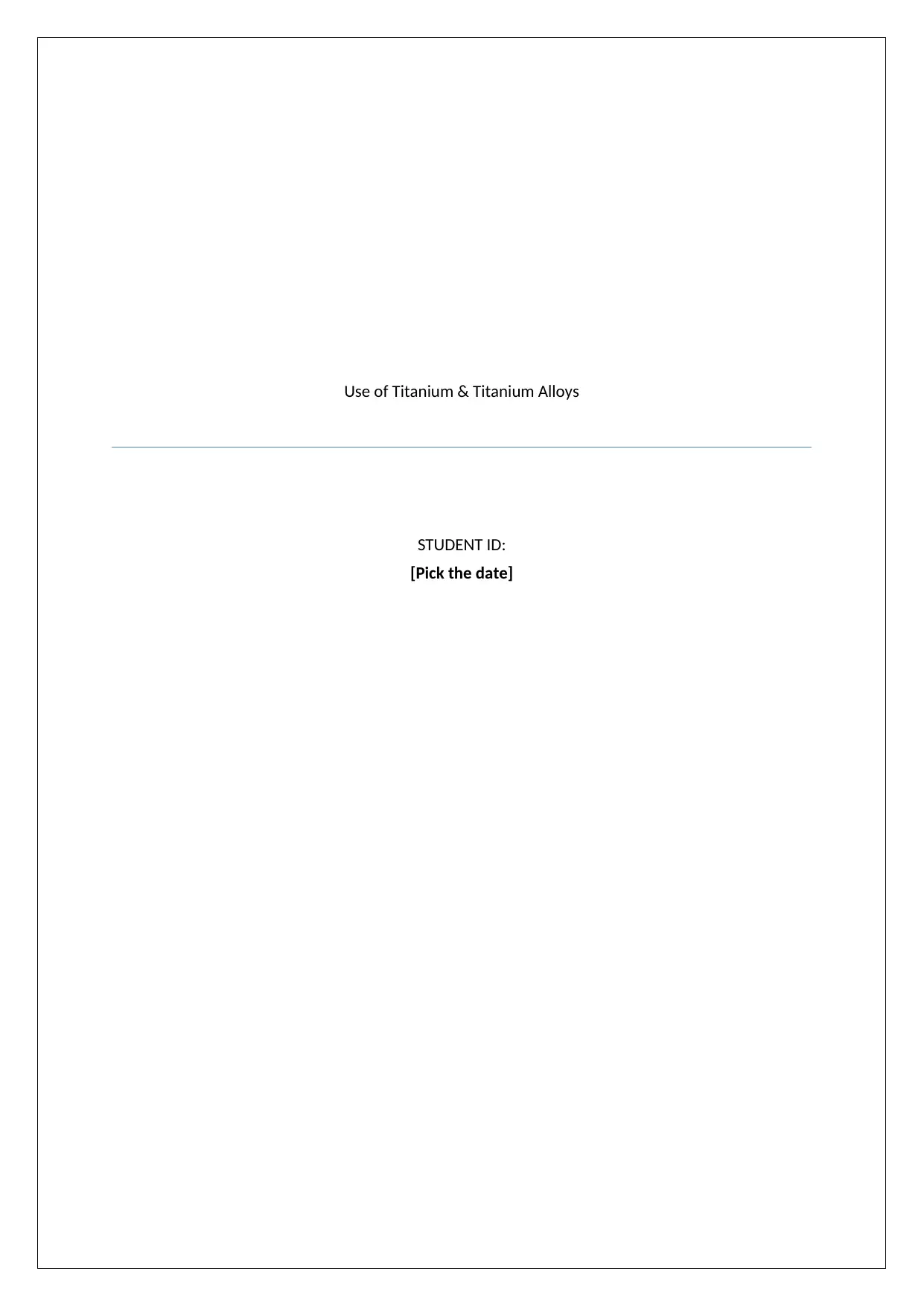
Use of Titanium & Titanium Alloys
STUDENT ID:
[Pick the date]
STUDENT ID:
[Pick the date]
Paraphrase This Document
Need a fresh take? Get an instant paraphrase of this document with our AI Paraphraser
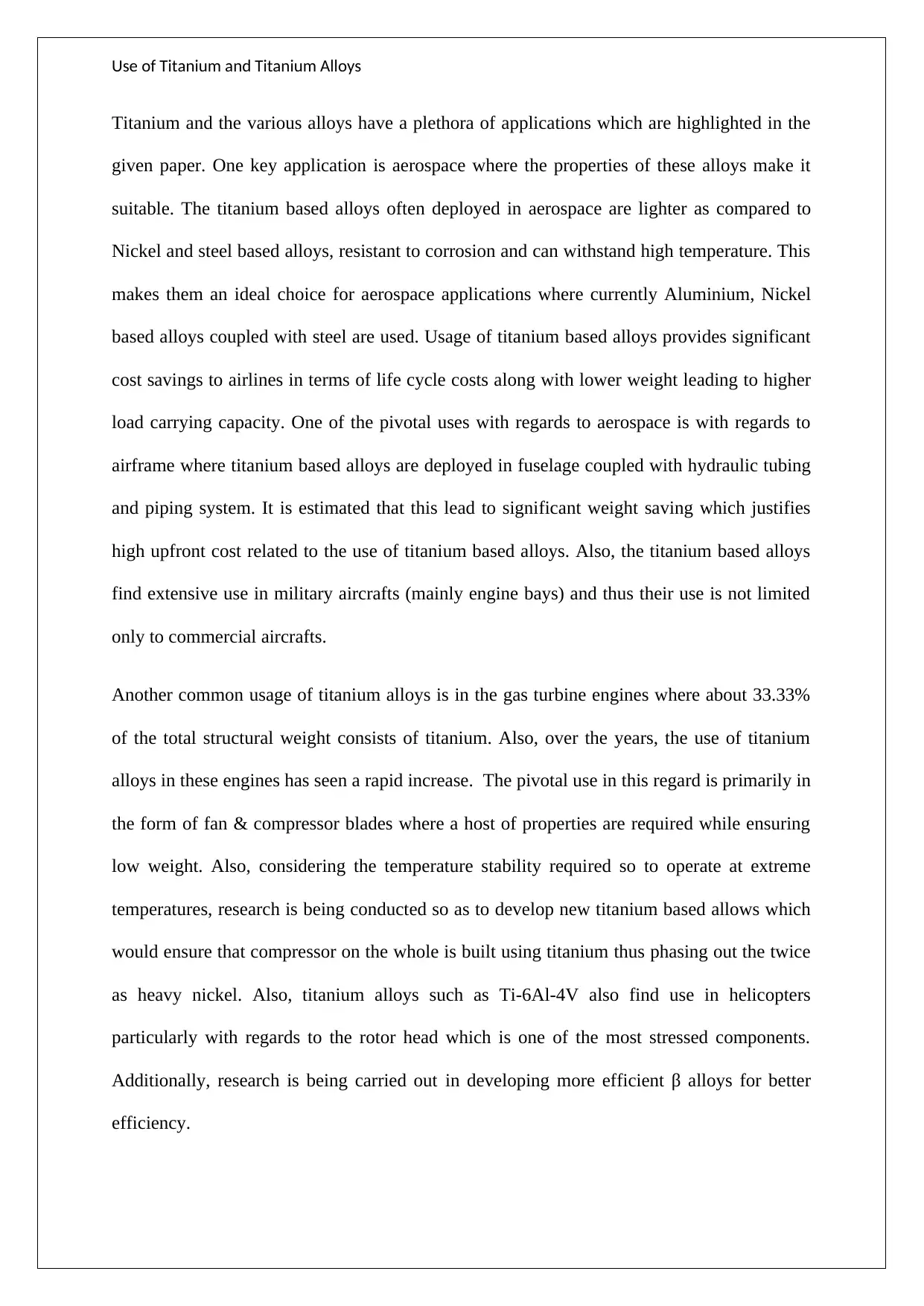
Use of Titanium and Titanium Alloys
Titanium and the various alloys have a plethora of applications which are highlighted in the
given paper. One key application is aerospace where the properties of these alloys make it
suitable. The titanium based alloys often deployed in aerospace are lighter as compared to
Nickel and steel based alloys, resistant to corrosion and can withstand high temperature. This
makes them an ideal choice for aerospace applications where currently Aluminium, Nickel
based alloys coupled with steel are used. Usage of titanium based alloys provides significant
cost savings to airlines in terms of life cycle costs along with lower weight leading to higher
load carrying capacity. One of the pivotal uses with regards to aerospace is with regards to
airframe where titanium based alloys are deployed in fuselage coupled with hydraulic tubing
and piping system. It is estimated that this lead to significant weight saving which justifies
high upfront cost related to the use of titanium based alloys. Also, the titanium based alloys
find extensive use in military aircrafts (mainly engine bays) and thus their use is not limited
only to commercial aircrafts.
Another common usage of titanium alloys is in the gas turbine engines where about 33.33%
of the total structural weight consists of titanium. Also, over the years, the use of titanium
alloys in these engines has seen a rapid increase. The pivotal use in this regard is primarily in
the form of fan & compressor blades where a host of properties are required while ensuring
low weight. Also, considering the temperature stability required so to operate at extreme
temperatures, research is being conducted so as to develop new titanium based allows which
would ensure that compressor on the whole is built using titanium thus phasing out the twice
as heavy nickel. Also, titanium alloys such as Ti-6Al-4V also find use in helicopters
particularly with regards to the rotor head which is one of the most stressed components.
Additionally, research is being carried out in developing more efficient β alloys for better
efficiency.
Titanium and the various alloys have a plethora of applications which are highlighted in the
given paper. One key application is aerospace where the properties of these alloys make it
suitable. The titanium based alloys often deployed in aerospace are lighter as compared to
Nickel and steel based alloys, resistant to corrosion and can withstand high temperature. This
makes them an ideal choice for aerospace applications where currently Aluminium, Nickel
based alloys coupled with steel are used. Usage of titanium based alloys provides significant
cost savings to airlines in terms of life cycle costs along with lower weight leading to higher
load carrying capacity. One of the pivotal uses with regards to aerospace is with regards to
airframe where titanium based alloys are deployed in fuselage coupled with hydraulic tubing
and piping system. It is estimated that this lead to significant weight saving which justifies
high upfront cost related to the use of titanium based alloys. Also, the titanium based alloys
find extensive use in military aircrafts (mainly engine bays) and thus their use is not limited
only to commercial aircrafts.
Another common usage of titanium alloys is in the gas turbine engines where about 33.33%
of the total structural weight consists of titanium. Also, over the years, the use of titanium
alloys in these engines has seen a rapid increase. The pivotal use in this regard is primarily in
the form of fan & compressor blades where a host of properties are required while ensuring
low weight. Also, considering the temperature stability required so to operate at extreme
temperatures, research is being conducted so as to develop new titanium based allows which
would ensure that compressor on the whole is built using titanium thus phasing out the twice
as heavy nickel. Also, titanium alloys such as Ti-6Al-4V also find use in helicopters
particularly with regards to the rotor head which is one of the most stressed components.
Additionally, research is being carried out in developing more efficient β alloys for better
efficiency.
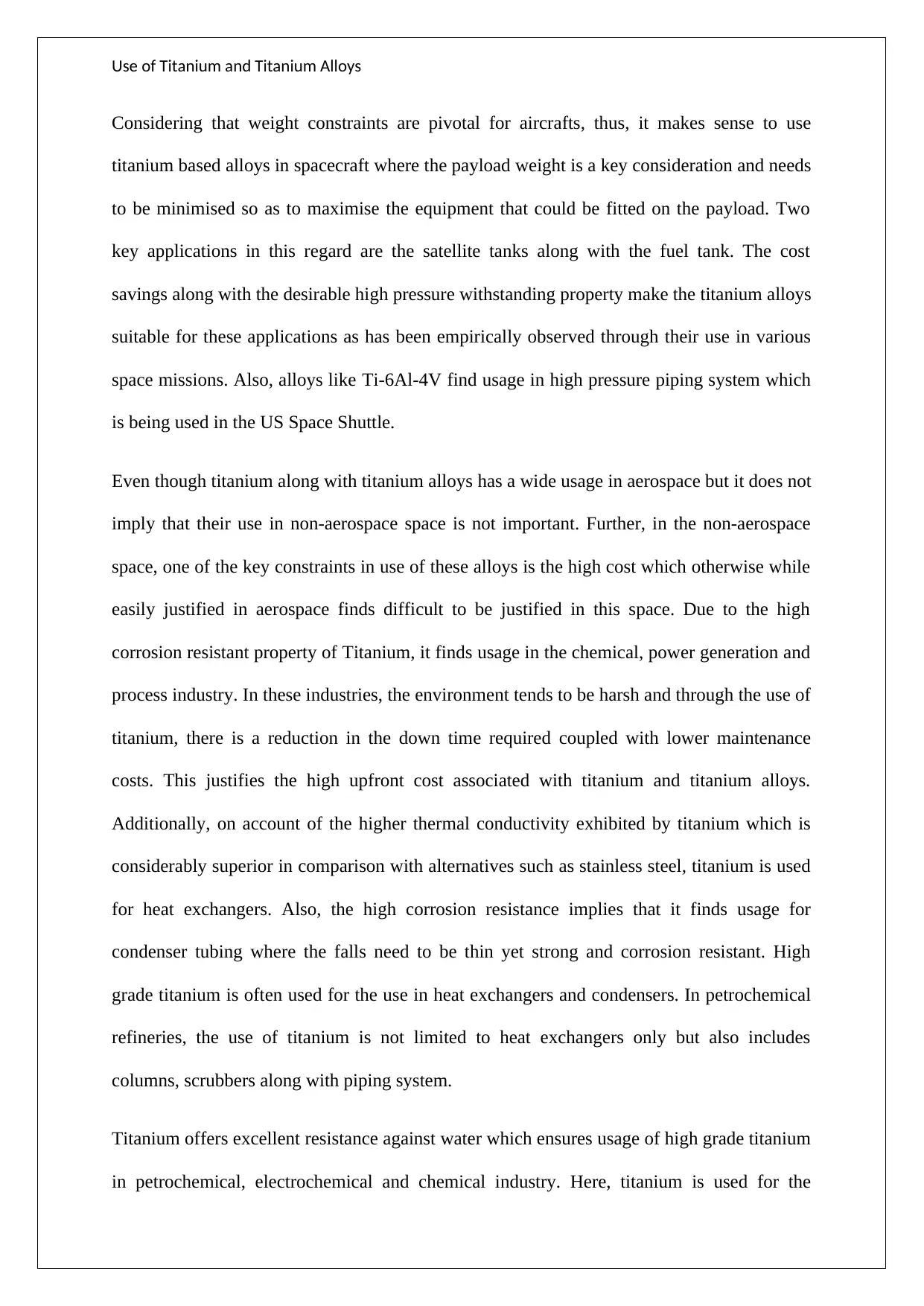
Use of Titanium and Titanium Alloys
Considering that weight constraints are pivotal for aircrafts, thus, it makes sense to use
titanium based alloys in spacecraft where the payload weight is a key consideration and needs
to be minimised so as to maximise the equipment that could be fitted on the payload. Two
key applications in this regard are the satellite tanks along with the fuel tank. The cost
savings along with the desirable high pressure withstanding property make the titanium alloys
suitable for these applications as has been empirically observed through their use in various
space missions. Also, alloys like Ti-6Al-4V find usage in high pressure piping system which
is being used in the US Space Shuttle.
Even though titanium along with titanium alloys has a wide usage in aerospace but it does not
imply that their use in non-aerospace space is not important. Further, in the non-aerospace
space, one of the key constraints in use of these alloys is the high cost which otherwise while
easily justified in aerospace finds difficult to be justified in this space. Due to the high
corrosion resistant property of Titanium, it finds usage in the chemical, power generation and
process industry. In these industries, the environment tends to be harsh and through the use of
titanium, there is a reduction in the down time required coupled with lower maintenance
costs. This justifies the high upfront cost associated with titanium and titanium alloys.
Additionally, on account of the higher thermal conductivity exhibited by titanium which is
considerably superior in comparison with alternatives such as stainless steel, titanium is used
for heat exchangers. Also, the high corrosion resistance implies that it finds usage for
condenser tubing where the falls need to be thin yet strong and corrosion resistant. High
grade titanium is often used for the use in heat exchangers and condensers. In petrochemical
refineries, the use of titanium is not limited to heat exchangers only but also includes
columns, scrubbers along with piping system.
Titanium offers excellent resistance against water which ensures usage of high grade titanium
in petrochemical, electrochemical and chemical industry. Here, titanium is used for the
Considering that weight constraints are pivotal for aircrafts, thus, it makes sense to use
titanium based alloys in spacecraft where the payload weight is a key consideration and needs
to be minimised so as to maximise the equipment that could be fitted on the payload. Two
key applications in this regard are the satellite tanks along with the fuel tank. The cost
savings along with the desirable high pressure withstanding property make the titanium alloys
suitable for these applications as has been empirically observed through their use in various
space missions. Also, alloys like Ti-6Al-4V find usage in high pressure piping system which
is being used in the US Space Shuttle.
Even though titanium along with titanium alloys has a wide usage in aerospace but it does not
imply that their use in non-aerospace space is not important. Further, in the non-aerospace
space, one of the key constraints in use of these alloys is the high cost which otherwise while
easily justified in aerospace finds difficult to be justified in this space. Due to the high
corrosion resistant property of Titanium, it finds usage in the chemical, power generation and
process industry. In these industries, the environment tends to be harsh and through the use of
titanium, there is a reduction in the down time required coupled with lower maintenance
costs. This justifies the high upfront cost associated with titanium and titanium alloys.
Additionally, on account of the higher thermal conductivity exhibited by titanium which is
considerably superior in comparison with alternatives such as stainless steel, titanium is used
for heat exchangers. Also, the high corrosion resistance implies that it finds usage for
condenser tubing where the falls need to be thin yet strong and corrosion resistant. High
grade titanium is often used for the use in heat exchangers and condensers. In petrochemical
refineries, the use of titanium is not limited to heat exchangers only but also includes
columns, scrubbers along with piping system.
Titanium offers excellent resistance against water which ensures usage of high grade titanium
in petrochemical, electrochemical and chemical industry. Here, titanium is used for the
⊘ This is a preview!⊘
Do you want full access?
Subscribe today to unlock all pages.

Trusted by 1+ million students worldwide
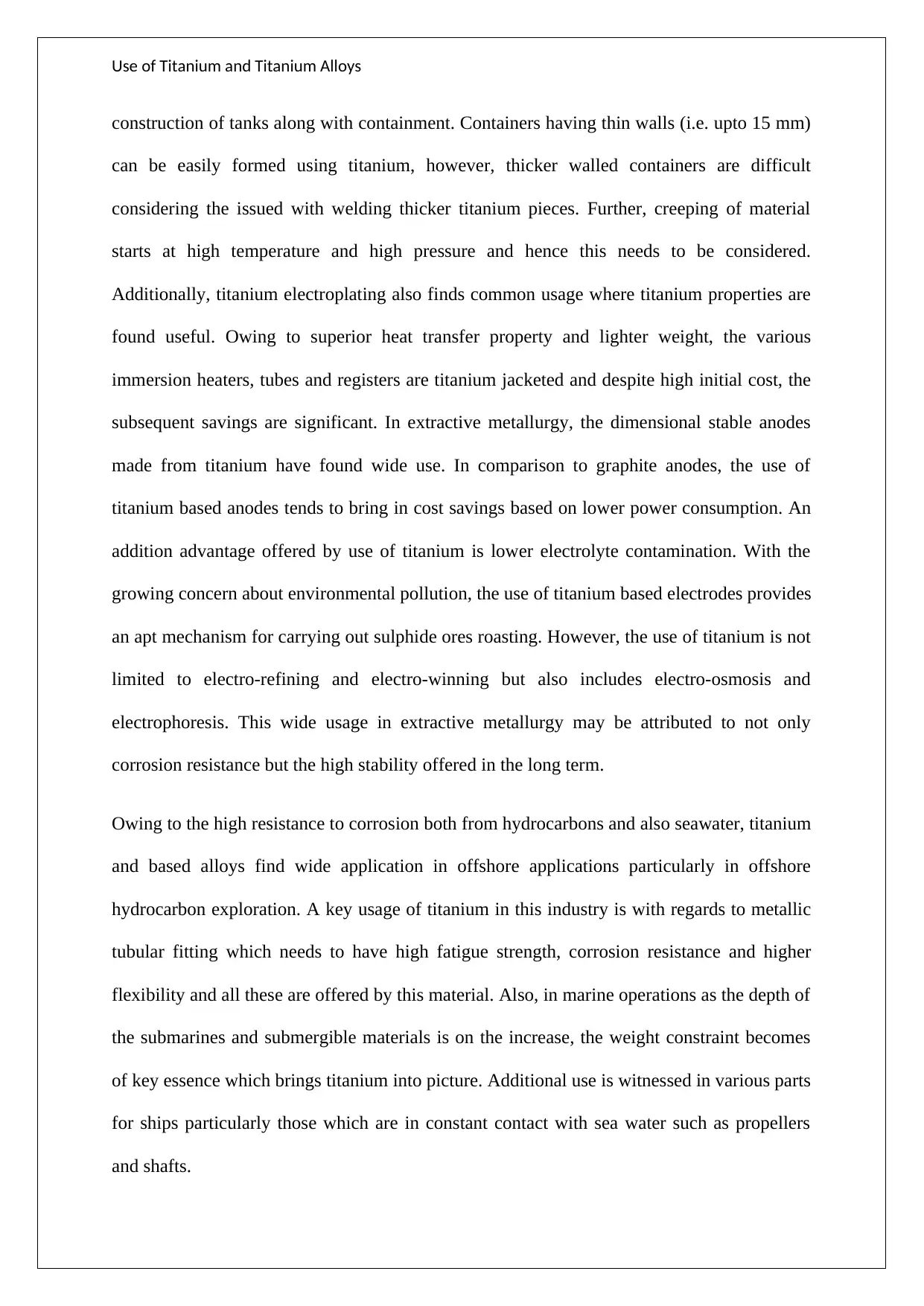
Use of Titanium and Titanium Alloys
construction of tanks along with containment. Containers having thin walls (i.e. upto 15 mm)
can be easily formed using titanium, however, thicker walled containers are difficult
considering the issued with welding thicker titanium pieces. Further, creeping of material
starts at high temperature and high pressure and hence this needs to be considered.
Additionally, titanium electroplating also finds common usage where titanium properties are
found useful. Owing to superior heat transfer property and lighter weight, the various
immersion heaters, tubes and registers are titanium jacketed and despite high initial cost, the
subsequent savings are significant. In extractive metallurgy, the dimensional stable anodes
made from titanium have found wide use. In comparison to graphite anodes, the use of
titanium based anodes tends to bring in cost savings based on lower power consumption. An
addition advantage offered by use of titanium is lower electrolyte contamination. With the
growing concern about environmental pollution, the use of titanium based electrodes provides
an apt mechanism for carrying out sulphide ores roasting. However, the use of titanium is not
limited to electro-refining and electro-winning but also includes electro-osmosis and
electrophoresis. This wide usage in extractive metallurgy may be attributed to not only
corrosion resistance but the high stability offered in the long term.
Owing to the high resistance to corrosion both from hydrocarbons and also seawater, titanium
and based alloys find wide application in offshore applications particularly in offshore
hydrocarbon exploration. A key usage of titanium in this industry is with regards to metallic
tubular fitting which needs to have high fatigue strength, corrosion resistance and higher
flexibility and all these are offered by this material. Also, in marine operations as the depth of
the submarines and submergible materials is on the increase, the weight constraint becomes
of key essence which brings titanium into picture. Additional use is witnessed in various parts
for ships particularly those which are in constant contact with sea water such as propellers
and shafts.
construction of tanks along with containment. Containers having thin walls (i.e. upto 15 mm)
can be easily formed using titanium, however, thicker walled containers are difficult
considering the issued with welding thicker titanium pieces. Further, creeping of material
starts at high temperature and high pressure and hence this needs to be considered.
Additionally, titanium electroplating also finds common usage where titanium properties are
found useful. Owing to superior heat transfer property and lighter weight, the various
immersion heaters, tubes and registers are titanium jacketed and despite high initial cost, the
subsequent savings are significant. In extractive metallurgy, the dimensional stable anodes
made from titanium have found wide use. In comparison to graphite anodes, the use of
titanium based anodes tends to bring in cost savings based on lower power consumption. An
addition advantage offered by use of titanium is lower electrolyte contamination. With the
growing concern about environmental pollution, the use of titanium based electrodes provides
an apt mechanism for carrying out sulphide ores roasting. However, the use of titanium is not
limited to electro-refining and electro-winning but also includes electro-osmosis and
electrophoresis. This wide usage in extractive metallurgy may be attributed to not only
corrosion resistance but the high stability offered in the long term.
Owing to the high resistance to corrosion both from hydrocarbons and also seawater, titanium
and based alloys find wide application in offshore applications particularly in offshore
hydrocarbon exploration. A key usage of titanium in this industry is with regards to metallic
tubular fitting which needs to have high fatigue strength, corrosion resistance and higher
flexibility and all these are offered by this material. Also, in marine operations as the depth of
the submarines and submergible materials is on the increase, the weight constraint becomes
of key essence which brings titanium into picture. Additional use is witnessed in various parts
for ships particularly those which are in constant contact with sea water such as propellers
and shafts.
Paraphrase This Document
Need a fresh take? Get an instant paraphrase of this document with our AI Paraphraser
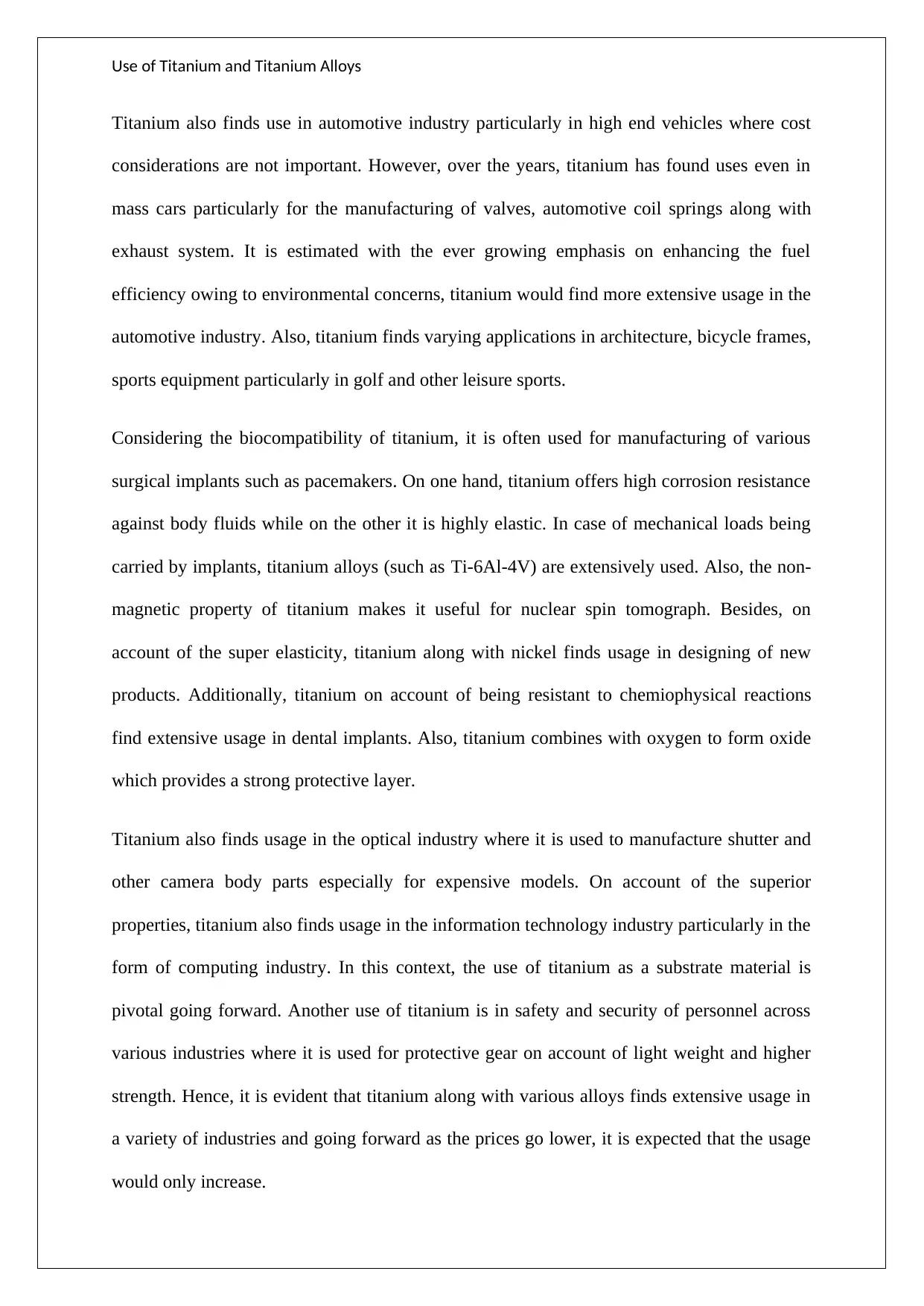
Use of Titanium and Titanium Alloys
Titanium also finds use in automotive industry particularly in high end vehicles where cost
considerations are not important. However, over the years, titanium has found uses even in
mass cars particularly for the manufacturing of valves, automotive coil springs along with
exhaust system. It is estimated with the ever growing emphasis on enhancing the fuel
efficiency owing to environmental concerns, titanium would find more extensive usage in the
automotive industry. Also, titanium finds varying applications in architecture, bicycle frames,
sports equipment particularly in golf and other leisure sports.
Considering the biocompatibility of titanium, it is often used for manufacturing of various
surgical implants such as pacemakers. On one hand, titanium offers high corrosion resistance
against body fluids while on the other it is highly elastic. In case of mechanical loads being
carried by implants, titanium alloys (such as Ti-6Al-4V) are extensively used. Also, the non-
magnetic property of titanium makes it useful for nuclear spin tomograph. Besides, on
account of the super elasticity, titanium along with nickel finds usage in designing of new
products. Additionally, titanium on account of being resistant to chemiophysical reactions
find extensive usage in dental implants. Also, titanium combines with oxygen to form oxide
which provides a strong protective layer.
Titanium also finds usage in the optical industry where it is used to manufacture shutter and
other camera body parts especially for expensive models. On account of the superior
properties, titanium also finds usage in the information technology industry particularly in the
form of computing industry. In this context, the use of titanium as a substrate material is
pivotal going forward. Another use of titanium is in safety and security of personnel across
various industries where it is used for protective gear on account of light weight and higher
strength. Hence, it is evident that titanium along with various alloys finds extensive usage in
a variety of industries and going forward as the prices go lower, it is expected that the usage
would only increase.
Titanium also finds use in automotive industry particularly in high end vehicles where cost
considerations are not important. However, over the years, titanium has found uses even in
mass cars particularly for the manufacturing of valves, automotive coil springs along with
exhaust system. It is estimated with the ever growing emphasis on enhancing the fuel
efficiency owing to environmental concerns, titanium would find more extensive usage in the
automotive industry. Also, titanium finds varying applications in architecture, bicycle frames,
sports equipment particularly in golf and other leisure sports.
Considering the biocompatibility of titanium, it is often used for manufacturing of various
surgical implants such as pacemakers. On one hand, titanium offers high corrosion resistance
against body fluids while on the other it is highly elastic. In case of mechanical loads being
carried by implants, titanium alloys (such as Ti-6Al-4V) are extensively used. Also, the non-
magnetic property of titanium makes it useful for nuclear spin tomograph. Besides, on
account of the super elasticity, titanium along with nickel finds usage in designing of new
products. Additionally, titanium on account of being resistant to chemiophysical reactions
find extensive usage in dental implants. Also, titanium combines with oxygen to form oxide
which provides a strong protective layer.
Titanium also finds usage in the optical industry where it is used to manufacture shutter and
other camera body parts especially for expensive models. On account of the superior
properties, titanium also finds usage in the information technology industry particularly in the
form of computing industry. In this context, the use of titanium as a substrate material is
pivotal going forward. Another use of titanium is in safety and security of personnel across
various industries where it is used for protective gear on account of light weight and higher
strength. Hence, it is evident that titanium along with various alloys finds extensive usage in
a variety of industries and going forward as the prices go lower, it is expected that the usage
would only increase.
1 out of 5
Your All-in-One AI-Powered Toolkit for Academic Success.
+13062052269
info@desklib.com
Available 24*7 on WhatsApp / Email
![[object Object]](/_next/static/media/star-bottom.7253800d.svg)
Unlock your academic potential
Copyright © 2020–2025 A2Z Services. All Rights Reserved. Developed and managed by ZUCOL.